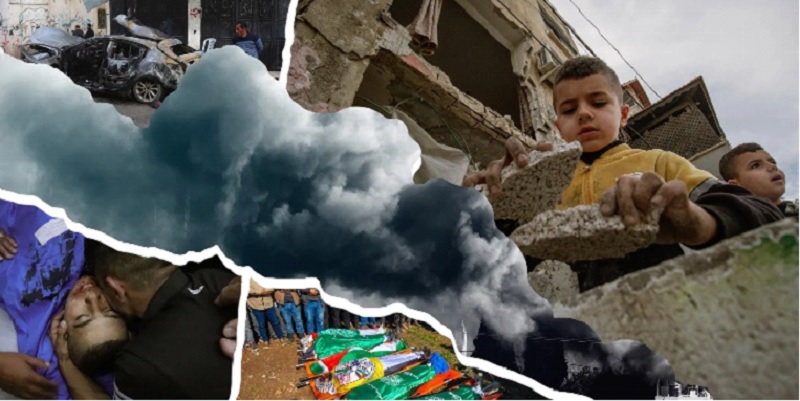By Catherine Cartier
As the car stopped, a few people walked by on the narrow street. Two motorbikes weaved past in different directions. “Everything was fine at the time,” according to an eyewitness sitting nearby in the camp’s main square.
Then the car erupted in a ball of flame. Two missiles fired from an Israeli drone had hit the Mazda in quick succession, as shown in a video the Israeli Air Force posted that night. According to the IAF, the strike killed Yasser Hanoun, described as “a wanted terrorist.
But Hanoun was not the only fatality: 16-year-old Said Raed Said Jaradat, who was near the vehicle when it was hit, sustained shrapnel wounds all over his body, according to documentation collected by Defense for Children International-Palestine. He died from his injuries at 1 a.m. the next morning.
Jaradat is one of 24 children killed in Israel’s airstrikes on the West Bank since last summer, when the Israeli forces began deploying drones, planes, and helicopters to carry out attacks in the occupied territory for the first time in decades.
With 37 bombings, helicopter gunship attacks, or drone strikes, the Israeli military’s air campaign has killed 55 Palestinians, including 24 children.
The world’s attention has been on the Israeli campaign in Gaza, which has killed at least 36,000 people -including more than 15,000 children- and prompted accusations of genocide from UN officials and at the International Court of Justice. In the name of eliminating Hamas in retaliation for the attacks in October, the Israeli military action in the Gaza Strip continues.
But Israel has also transformed its tactics in the West Bank. Since June of last year, and with increasing regularity during the Gaza offensive, the Israel Defense Forces have shown a new willingness to use air power in the West Bank, regardless of the collateral damage to children and other civilians caught in the blasts.
An open-source Intercept investigation documented at least 37 Israeli airstrikes, drone strikes, and attacks by helicopter gunships in the West Bank since June 2023, which have killed 55 Palestinians, according to the United Nations.
Most attacks struck densely populated urban areas and refugee camps in Jenin, Tulkarem, and Nablus, all in the northern part of the West Bank.
The Israeli military repeatedly stated on social media that the strikes were carried out to kill terrorists. But this investigation identified a different pattern: Nearly half of the people killed in the strikes were children.
Some of the children killed were throwing homemade explosives at Israeli troops, or were close to armed men when they were killed. Many were unarmed and uninvolved in any confrontations. Their ages ranged from 11 to 17.
The database of attacks was compiled using information published by news outlets, the Negotiations Affairs Department of the State of Palestine, and the Israeli military.
The determination of whether children were killed in the process is based on publicly available information and documentation gathered by Defense for Children International-Palestine. The Israeli military did not respond to multiple requests for comment on the findings of this investigation.
Many of these strikes are part of a broader Israeli campaign of targeted killings: assassinations of individuals by Israeli forces that, despite the name, often kill people who happen to be near the target at the time of the strike. Targeted killings, and these aerial attacks more broadly, are considered by some experts to be likely violations of international law.
“One of the things this says, which is not particularly surprising, is that the Israeli military is far more concerned about protecting the lives of its soldiers than it is with protecting the lives of civilians who may be killed when they drop bombs from the sky,” said Yousef Munayyer, head of the Palestine/Israel program and senior fellow at the Arab Center Washington DC.
The airstrikes began last June.
Ashraf Morad Mahmoud Al-Sa’di, 15, was killed by a drone strike -the first fatal strike documented in the West Bank since the Second Intifada- alongside two young Palestinian men in agricultural lands close to the Al-Jalameh military checkpoint, near the wall between Israel and the occupied territories.
According to documentation collected by DCI-P, Al-Sa’di and the two men opened fire at Israeli military vehicles, and were later killed by a drone strike in their car.
After October 7, however, the pace of the airstrikes accelerated. Eight children, ages 11 to 17, were among over a dozen people killed in a series of drone, helicopter, and plane attacks on Jenin and the Nur Shams refugee camp late that month.
In November, four children, ages 12 to 16, were killed over the course of seven drone strikes across the West Bank. On December 12, a strike killed a 17-year-old who was standing near three armed men.
Some of the children killed in the first months of airstrikes were described as armed or throwing homemade explosives at Israeli soldiers carrying out raids into the West Bank, according to DCI-P documentation. In other cases, what the children were doing in the moments before their death is unclear and could not be confirmed by DCI-P.
But in the waning days of 2023, two children -unarmed, uninvolved- were also targeted and killed by an Israeli drone strike, which took place on December 27, during an Israeli raid on Nur Shams camp, one of 48 raids across the West Bank that day.
While the Israeli forces destroyed parts of a kindergarten building, Palestinian fighters confronted them. In the words of the Israeli Air Force, “A terrorist squad was identified that threw explosives at the forces, and an Air Force aircraft attacked the squad.” Six people were killed, and another six were injured.
Hamza Ahmad Mostafa Hmaid, 16, and Ahmad Abdulrahman Issa Saleh, 17, were among the dead. Hmaid and Saleh had not been a part of the group confronting Israeli soldiers, DCI-P reported.
They would not be the last unarmed, uninvolved children to die from an Israeli missile strike. On January 7, Wadea Yaser Hasan Asous, 17, was killed by a drone-fired missile near Jenin. Israeli forces were withdrawing after a raid when a group of Palestinians confronted them with explosives, according to documentation gathered by DCI-P.
After the Israeli vehicles left the area, an Israeli drone fired on a different group of Palestinians, including Asous, who were sitting around a fire near an all-night cafe. Seven Palestinians, including four brothers, were killed in the attack.
Later in January, a drone strike during a raid on the Tulkarem refugee camp killed three Palestinian boys, all aged 17. The boys were walking near an armed young man, according to DCI-P, but were themselves unarmed and were not participating in confrontations. Seven other people, including three paramedics, were injured in the raid.
The airstrikes have not let up. In the February strike on the white Mazda, 16-year-old Jaradat was fatally injured. On a single night in March, five individuals were killed in drone strikes in Jenin and Tulkarem.
A total of six children have been killed this year to date in aerial attacks in the West Bank, as documented by DCI-P. In the latest attack, on June 6, an IDF helicopter carried out strikes during a raid in Jenin. The gunship’s missiles did not kill, but Israeli forces shot and killed three Palestinians, including one child, in the raid.
Bombs and missiles don’t only kill; they also maim those nearby. After an airstrike on Jenin last fall that sent roughly 20 people to the hospital, Doctors Without Borders, also known as Médecins Sans Frontières, or MSF, published an account of the scene.
“Patients had lost their limbs, lost their legs,” said Dr. Elma Wong, an anesthetist with the group. “Lots of shrapnel injuries, which meant a piece of metal [went] into the chest, into the abdomen, into the head.” Two patients didn’t survive.
Israel’s reintroduction of air attacks in the West Bank comes alongside the intensification of land incursions, also called raids. In the year before October 2023, Israeli forces launched an average of 600 raids per month in the occupied territories. In the months since, raids have ratcheted up to over 1,000 per month. Israeli soldiers and settlers in the West Bank killed 507 Palestinians -including 121 children- in 2023, according to DCI-P, making last year the deadliest for Palestinians in the West Bank since 2005, when the UN started recording casualties.
The Israeli military last regularly used air power in the West Bank during the Second Intifada, which lasted from September 2000 to February 2005, often in pursuit of assassinations, or targeted killings.
“The marriage of combat helicopters with special ground forces has become our ‘dream team’ for targeted killing operations,” remarked an Israeli general in 2003. By January 2005, media and defense sources reported over 550 attacks by the IAF on Palestinian targets.
These targeted killings weren’t only deadly for those targeted. According to B’Tselem, a Jerusalem-based human rights nonprofit, targeted assassinations killed 103 Palestinians in the West Bank and Jerusalem during the Second Intifada. Just over 75 percent of those killed were the targets; the rest were collateral damage.
At the time, the US government vocally opposed these killings, referring to them explicitly as assassinations. “The US government is very clearly on the record as against targeted assassinations,” said US Ambassador to Israel Martin Indyk in July 2001, on Israeli broadcast television.
Today, as the targeted killings continue, the State Department did not respond to repeated requests for comment on the current US position on such killings or on the Israeli forces’ use of air power in the West Bank.
In 2006, the Israeli Supreme Court ruled that targeted killings in the West Bank and Gaza had to be investigated after the fact to determine whether the killings met proportionality and targeting norms, but recent scholarship has questioned the “composition, objectivity, and independence” of the committees carrying out these investigations.
“The doubt with Israel is that there has been so much impunity for Israeli violations, that nobody trusts such a process,” Ben Saul, the UN special rapporteur on counter-terrorism and human rights, told The Intercept.
Several factors have contributed to this new wave of airstrikes in the West Bank. In part, they’re the result of an evolution in military tactics by both Israeli and Palestinian combatants.
This campaign marks Israel’s first use of armed drones in the West Bank since the Second Intifada -and the first time the IDF is announcing its use of drone strikes in the West Bank as they happen on social media. The IDF used drones to assassinate militants in Gaza in the intervening years, according to leaked documents, but until 2022, the government actively censored mentions of their use in the Israeli press.





